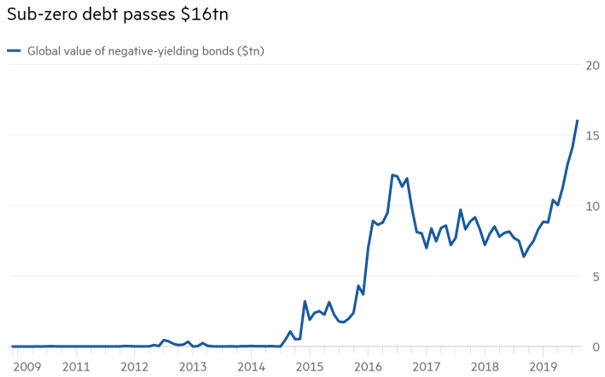

As western civilisations continue to be disrupted by falling average wages, mainly due to the continuing rise of the ‘uba’ business models, governments will fail to see the necessary cures and continue to attempt to alleviate economic stress using macro economic processes such as tax and interest rates.
The continuing rise and influence of companies such as Google, Microsoft, Facebook et al will create a continuing decline in real wages for many by taking a significant share of the wealth created from their services for their own shareholders and senior people. This will mean that the populations of Europe and Northern America will continue to see a decline in real terms of wealth and job satisfaction. There will be a smaller proportion of key workers who benefit from all this wealth creation process. Interest rates will continue to be limited or to fall to zero, or become negative.

CST believes this is the ‘economic Gaia’ effect. This ‘Gaia’ effect will attempt to maintain the economic fundamentals with changing circumstances. As the move to remove the ‘worker’ from the wealth creation process and as the value of ‘capital’ becomes less important the ‘money’ system reflects this change by indicating that the future value of the ‘money’ is less. The money created from holding any capital base becomes less valuable as the capital becomes less important to the overall wealth creation process.
Eventually, as the capital impact and worker impact on wealth creation tends to zero, so must the value of the money. Thus the fall in interest rates, or indeed negative interest rates – suggesting that the value of the money (capital and worker output) is reducing over time.
As automation increases during the twenty first century, so will this Economic Gaia effect. Money will become less important as it will not represent the way wealth is created.
(Note that Google's Waymo has recently announced that removing the 'safety driver' from some of its driverless vehicles, ratcheting up the move to wider adoption of fully automated vehicles - in less than 30 years driving will not be a job).
Along with this change will be the inevitable climate change impacts. These will continue to unveil increasing costs and real reductions in the ability for all counties to provide food, water and essential services while increasing the costs for everyone for mitigation and repair work directly due to climate based physical destruction and changing weather patterns.
In about fifteen years (2035) this will start to significantly impact the lifestyle of the middle classes within Europe and North America. At this point a political backlash will create a movement for change.
Who will lead the next 'revolution' and why
There are two possibilities at this crossroads; either a move to an authoritarian regime by locking down the populous; or a move to a different economic model, perhaps based on the Norwegian economic socialist model. CST predicts that the Norwegian model will prevail and this is how it will come about:
France will lead this mini-revolution. It is well placed to assert a socialist movement and public revolt due to France’s inherent anti-establishment history for public dissent, along with its reliance on agricultural and a regional economy.
France will step-up with civil disobedience and insist that its governance provides a living wage for everyone. A new political movement will establish the creation of a modern socialist state where the large businesses are nationalised. Foreign companies, such as the north American FANGS will also either be taken into this new system or banished from trading.
A living wage for everyone will be created and France will ask the European union to provide the money to fund this, If the EU does not comply, (initially likely), then France will create a new digital currency. At this point in time it will have become clearer that the national and world debt is becoming increasingly meaningless as the basis for wealth creation is moving inexorably away from the ‘capital and worker’ base that it has always been predicated upon.
The EU as a whole, being subject to the same demands, will fall into line. This will create a European wide Norwegian based socialist systems with a living wage for all, funded by debt.
North America will eventually follow, (delayed by quite a few years), but the increasing power of China and India will mean that they will have to choose a path either to go it alone or join the European lead socialist movement.
By 2060, the world will be quite different. Europe, having chosen a more socialist path with a living wage and understanding (eventually) that automation is key to future success will maintain their economic advantage. China, will continue to be authoritarian, but will essentially be moving in the same direction. India is now a major power and it too sees the impacts of automation and global climate changes to its fundamental existence.
At this time somewhere between 2050 and 2080 the main powers decide to move together to create world bank with a new type of trading system predicated upon limiting and repairing climate damage. The world begins its first foray into centralised control, trade based on a different economic model that is fundamentally about sharing world resources while providing for individual living conditions.
Africa, now still leading the rise in world population, is seen as a necessary partner for alleviating the worst of the climate changes. The world pulls together to harnesses Africa’s ability to create massive solar power and provide significant natural resources.
While there continues to be significant difference in cultural outlooks across the major powers, there is a fundamental understanding that the world’s continuing human existence requires acceptance of basic values and the need to prevent major runaway global climate change from creating massive food and water shortages for every nation.
At last, in 2080, there is a breakthrough in fusion power. The world has created a significant long-term fusion power process that can be rolled out across the world.
In 2090 the first significant improvement in climate destruction becomes effective. The removal of a massive amount of carbon dioxide from the atmosphere by an international team shows that climate change can be contained and maybe reversed.
The world has side-stepped what is potentially the worst case scenario for self-destruction. What next?
Thank You,
CST
CST Predicts the future
August 2019
CST likes predictions. We are happy to put forward a future that we think is likely - based on falling interest rates, the 'economic Gaia effect' and more...